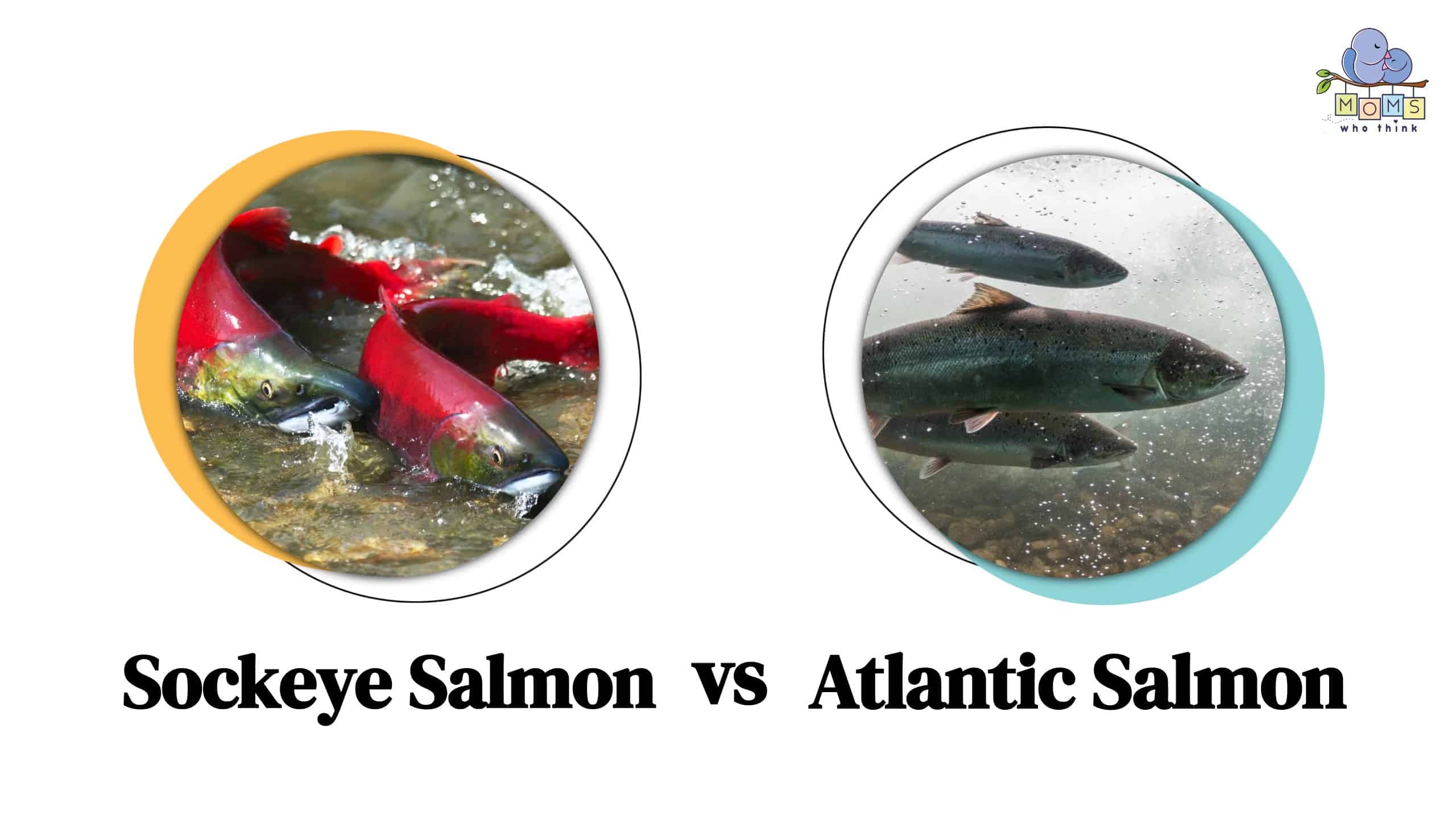Salmon is among the most nutrient-filled foods. It's tasty and quite versatile. There are different varieties of salmon worldwide, including sockeye and Atlantic salmon. All salmon fish have distinct characteristics, and sockeye and Atlantic are no different. But can you tell them apart? Sockeye salmon is small in size with a reddish color, while Atlantic salmon is a large pale orange fish.
In this post, we look at some of the things that distinguish sockeye and Atlantic salmon, like flavor and appearance, nutritional value, health benefits, and more.
Sockeye vs. Atlantic Salmon: Factors That Differentiate Them
Habitat
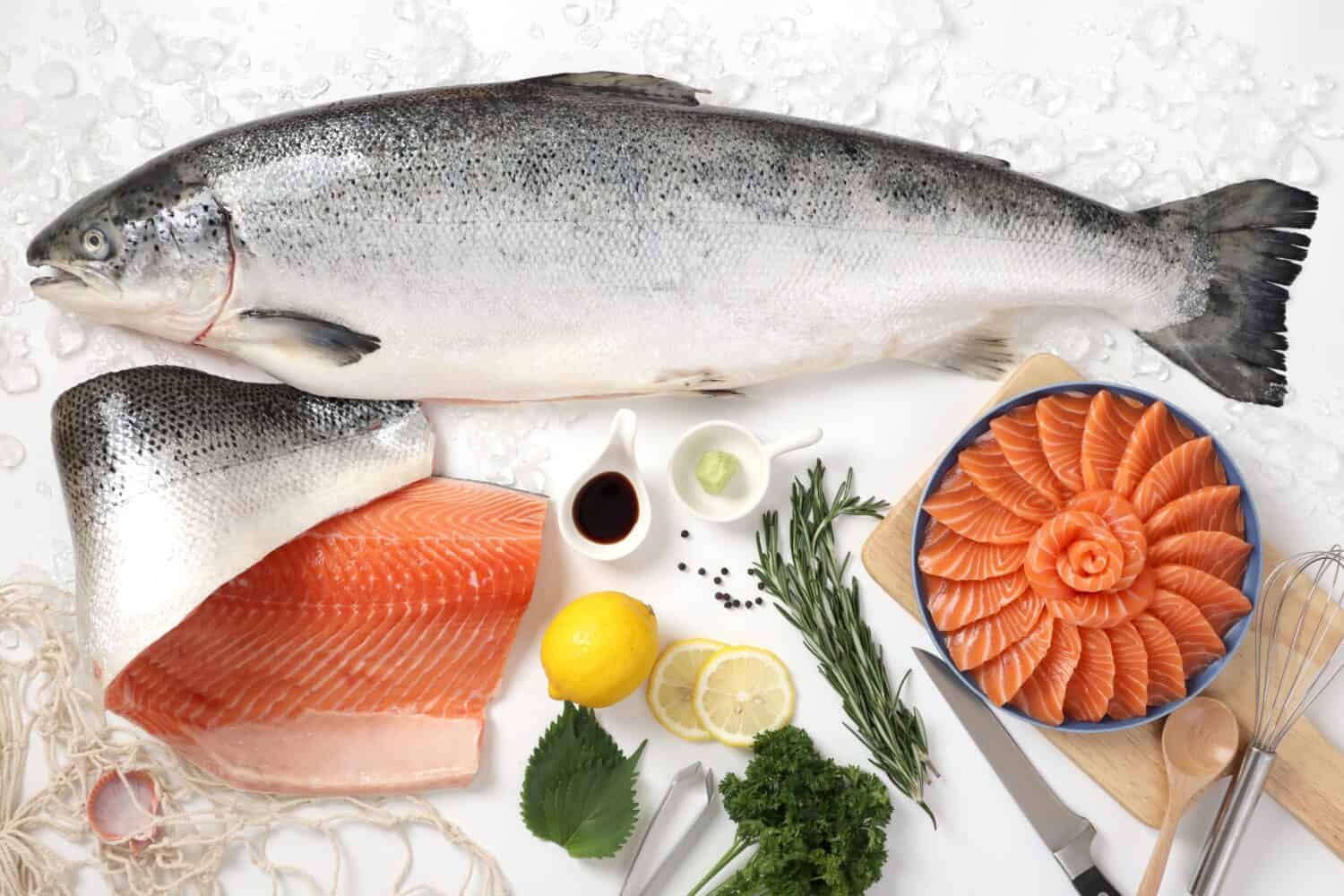
©anantachai phothep/Shutterstock.com
Sockeye and Atlantic salmon are similar yet different. They come from the salmon family, but each species has unique qualities resulting from where and how they spend their life. They spend their time between fresh and salty waters. But sockeye originates from the Pacific Ocean and the water bodies on the West Coast. Atlantic salmon initially came from the Atlantic Ocean and the East Coast water bodies, but now it is farm-raised.
Appearance
Something else that makes both fish differ is their physical appearance. As much as they are found in different environments, knowing their appearances helps to identify them correctly, especially when buying. Sockeye is more colorful than Atlantic salmon. It has a green head, white mouth, bright golden eyes, and a bright red body. The Atlantic kind has a tanned body with pale orange or brown spots.
Size
Besides color, size comes in closely during differentiation. Sockeye is one of the smallest, if not the smallest, salmon species. It weighs 15 pounds or less compared to the Atlantic salmon, which is approximately 30 pounds. Note that the weight only refers to these fish when fully grown, as little salmons are much smaller.
Flavor and Culinary Use
A final and necessary variance between Atlantic salmon and sockeye is their taste or flavor and culinary use – how these types of fish taste is highly influenced by their habitats and ways of life. Sockeye is a wild-caught fish making it one of the boldest wild salmon species. On the other hand, Atlantic salmon is farm-raised and often referred to as farmed Atlantic salmon. These environments give them their respective flavors.
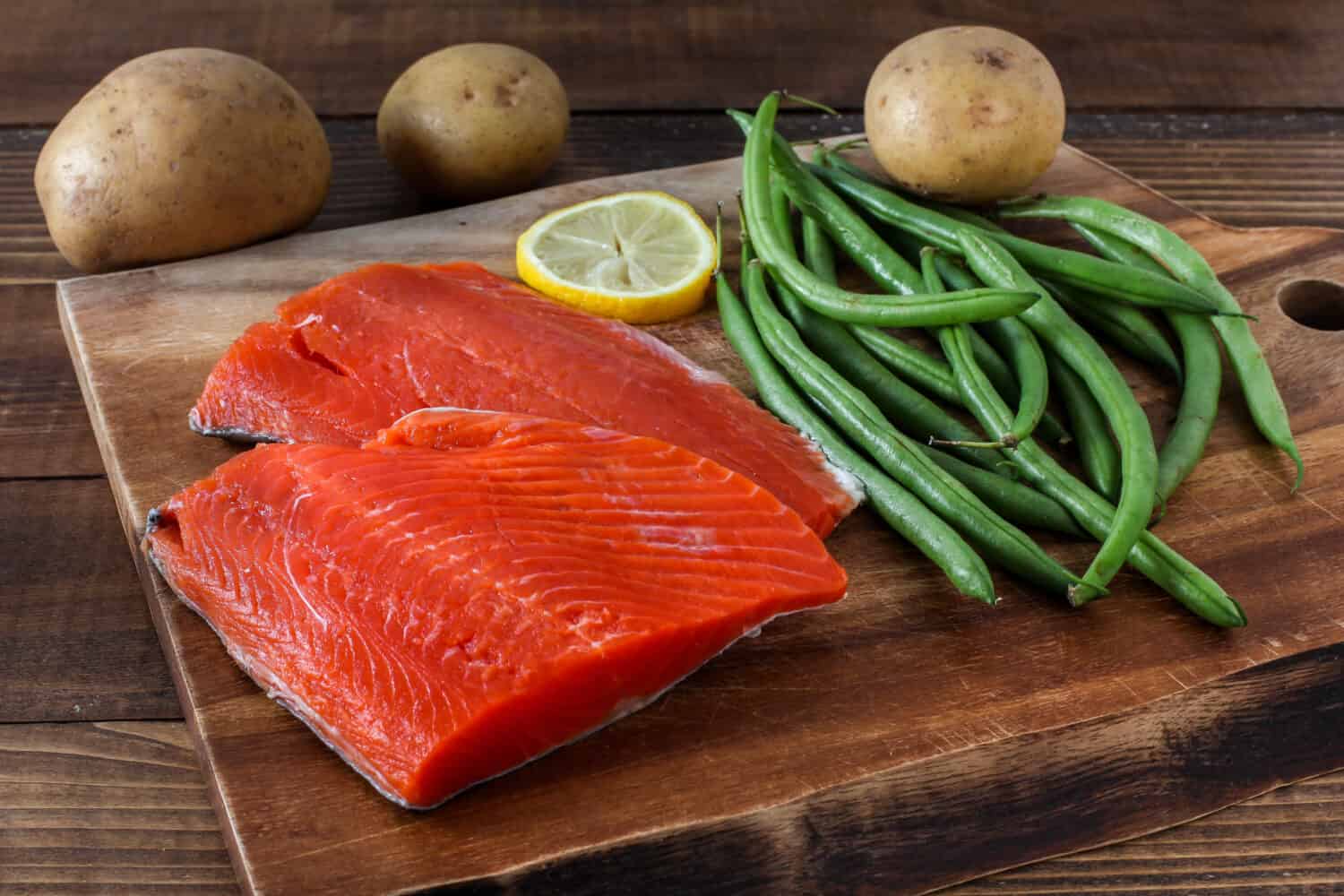
©Miro Vrlik Photography/Shutterstock.com
Most people are surprised at the first bite of sockeye. It has a robust flavor known as the ‘salmon forward' flavor. Its varied diet of brine, shrimp, plankton, and krill gives it a bold taste that allows you to eat it alone or pair it with a side dish of choice. The succulent and flaky texture also contributes to the overall flavor. It looks meaty and lean but has a good amount of fats, especially Omega-3 fatty acids.
High-fat amounts influence the taste of most fish, but it's slightly different for Atlantic salmon. It is delicious but is not as good as sockeye. Since they are farm-raised, what they feed on is limited compared to what sockeye eat hence their mild and less flavorful nature. Their soy and corn pellets diet makes them more fat than sockeye. They have excessive Omega-6 fatty acids, which are fantastic when cooking to avoid dryness. However, it's detrimental to the body as it increases the risk of chronic diseases.
Atlantic salmon is suitable for various culinary applications, unlike sockeye, whose uses are few. You can get Atlantic salmon all year round, fresh or frozen hence the variety of use. It is also quite affordable compared to sockeye, which is highly prized and rare, thus limiting its culinary use.
Sockeye vs. Atlantic Salmon: Nutritional Value
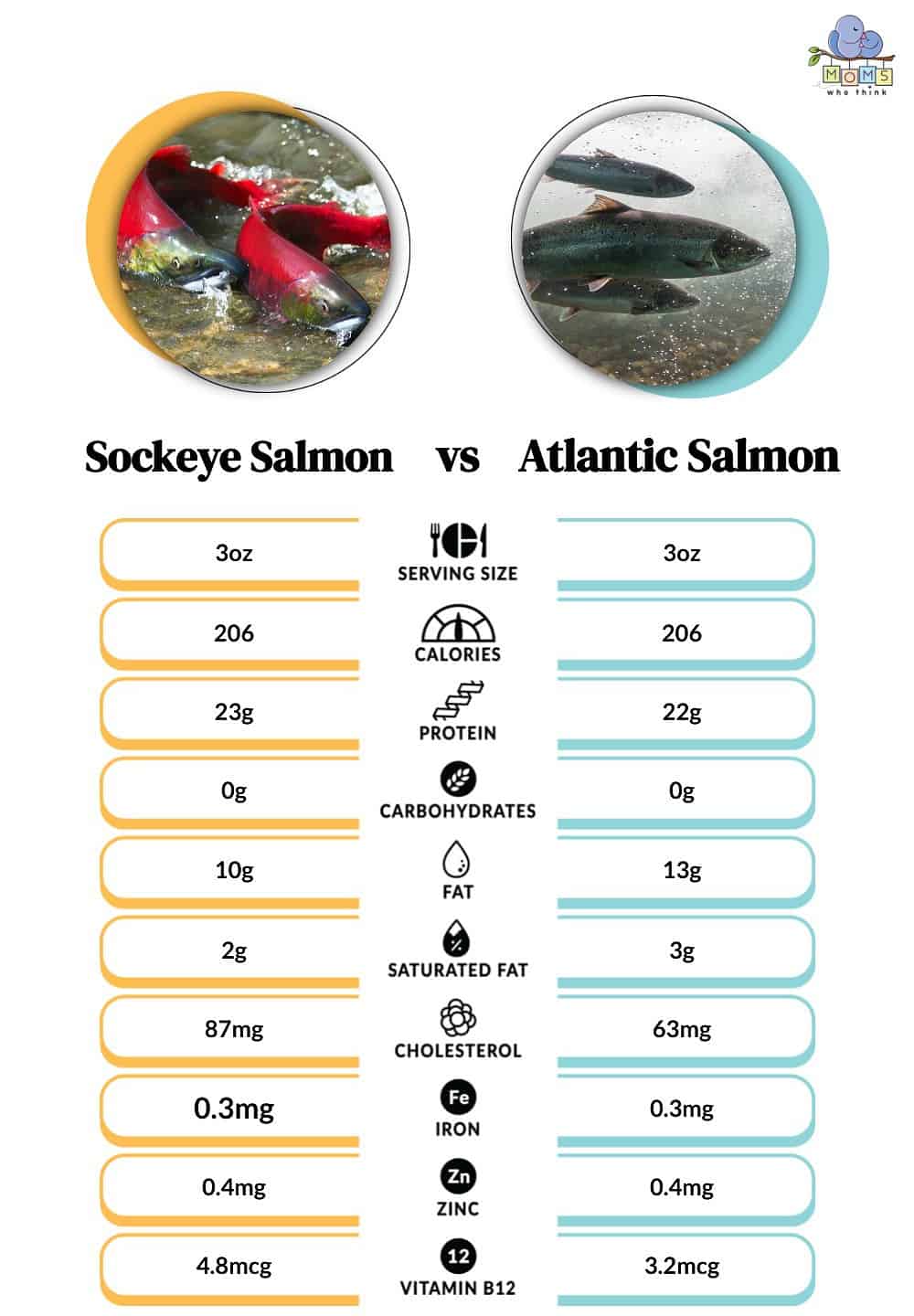
©
Atlantic salmon has more calories than sockeye. In a 3-ounce fillet, the first presents 206 calories, while the latter has the same 206 calories. Atlantic salmon has a higher total fat content than its counterpart. It has more fat than sockeye, i.e., 13g versus 10g. It means that the saturated and unsaturated fats and Omega-3 and 6 fatty acids are a lot. The protein content in sockeye is more since it's leaner. In every 100-gram serving, you'll get 26 grams of it and 19 grams of Atlantic salmon. Other nutrients in both fish appear in almost similar percentages. They include sodium, potassium, calcium, iron, phosphorus, and copper.
Sockeye and Atlantic salmon have defined nutritional profiles. However, the calories you get from each also depend on the cooking methods. If you use too much fat, the dish will be high in calories; the opposite is true when using less fat.
What is Sockeye?
Sockeye is a salmon species scientifically known as Oncorhynchus nerka. Most buyers call it red salmon based on its body color. It breeds in the open ocean of the Pacific, in the Northwest of the Pacific, and around Alaska. Bristol Bay in Southwest Alaska is a famous spawning spot for sockeye. Being a wild fish, it's a great source of food and nutrients for communities on and off the Pacific coast.
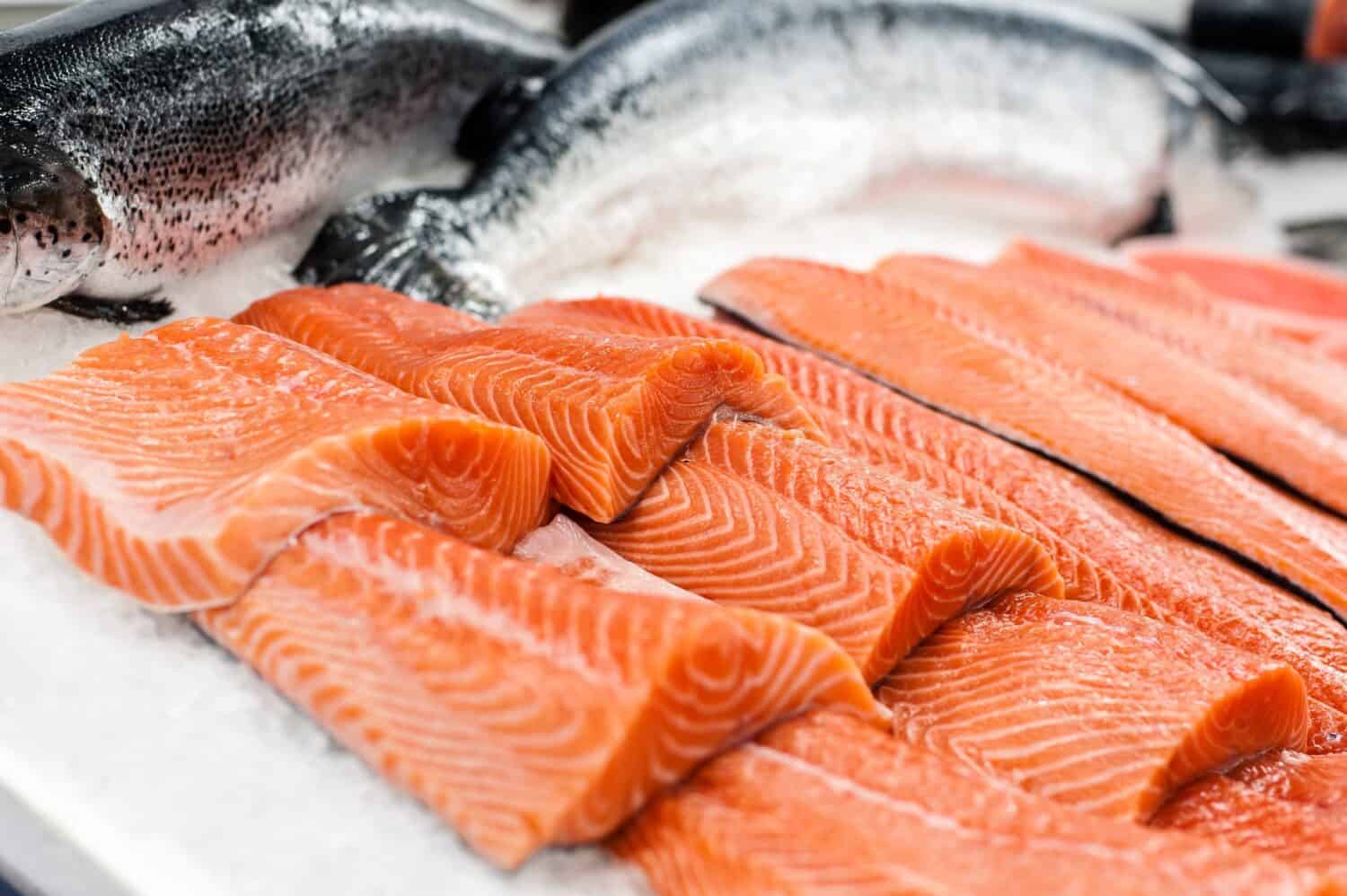
©Taras Shparhala/Shutterstock.com
Sockeye is a seasonal fish, so it's expensive when available. It has a robust, rich taste and a meaty, chewy texture with little fat. Its deep red color from the carotenoid astaxanthin in its meat makes it stand out from other fish. Its diet also contributes to its flesh and skin color.
What is Atlantic Salmon?
Atlantic salmon is the only native salmon species to the Atlantic Ocean. It is the third biggest of all salmon varieties, with a pale orange body. Initially, this fish stayed in the wild like sockeye, but it became endangered over time, so now it's only farm-raised. Fishermen cannot fish the Atlantic salmon due to the imposed ban in an attempt to restore its population in the wild. All Atlantic salmon in markets is from farms that feed on corn pellets.
It has a mild flavor with a soft and fatty texture. Some people find it bland, but the lack of an intense taste enables you to experiment with different seasonings and spices to give it a fantastic flavor. It's a year-round fish, so you can use it for recipes anytime. Atlantic fish is more prominent and cheaper than sockeye, hence available for multiple culinary applications.
Cooking of Sockeye
There are several ways of cooking sockeye salmon, but grilling is the most popular. Remember, sockeye is small, so its fillet is thinly compared to Atlantic salmon's. Grill the fillets skin facing down, and don't turn until done. Traditionally, the fish was made on cedar planks, but other cooking methods besides grilling and the latter are used. You can roast it slowly, avoiding overcooking, which can cause drying. Oven baking is also a good idea, as well as cooking in foil or frying.
The taste of sockeye already steals the show since it's very intense. But, some cooks still add spices and herbs. They believe you can balance the fish flavor and the seasonings and create something pretty tasty without dominating the other. Others believe the ‘salmon forward' flavor should be maintained by keeping things simple. This means they only use salt, pepper, lemon juice, and butter on the flesh to enhance the rich sockeye flavor.
Cooking Atlantic Salmon
Fish lovers choose Atlantic salmon for its soft and tender flesh. The high-fat content makes it moist and prevents drying during cooking. Regarding the cooking style, Atlantic salmon does well when served pan-fried, baked, or roasted. The mild flavor is like a blank canvas where you try various spices to find what works best. Some good seasonings include red pepper flakes, dill, garlic, and cilantro. Salt, butter, and lemon juice are great additions too.
Sockeye vs. Atlantic Salmon: Are They Dyed?
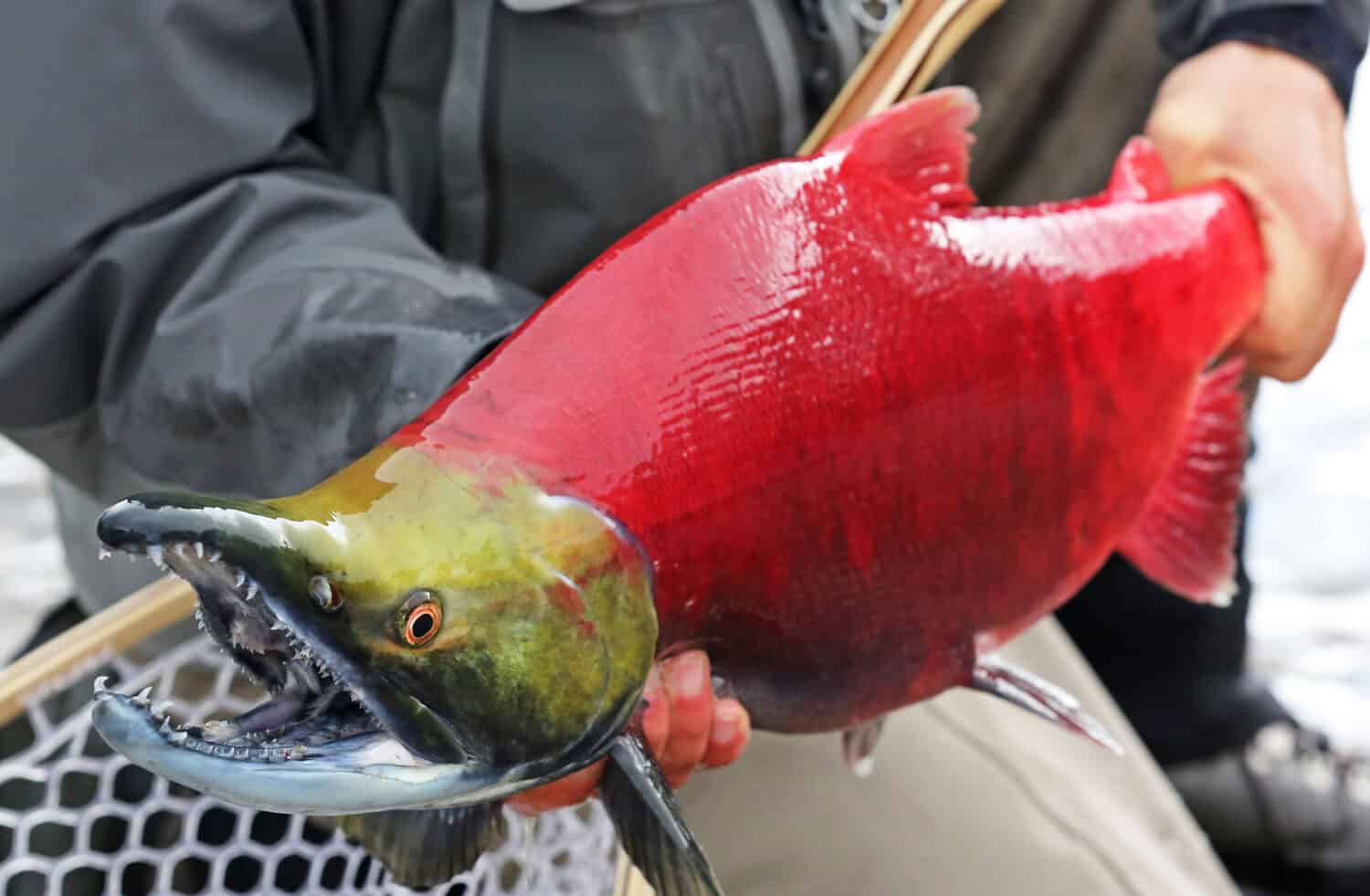
©Iryna Harry/Shutterstock.com
No dyeing happens on sockeye salmon because it already has a deep, vibrant red hue. It gets its color from carotenoids available in its zooplankton, shrimp, and krill diet. As for Atlantic salmon, dyeing takes place indirectly. Farmers use a color wheel to identify the hue they want for fish when it matures. They enhance their feed with dyes from astaxanthin carotenoid. Corn and soy, the primary foods for Atlantic salmon, are filled with dye to make the fish pink or pale orange when it gets to the market. Without the shade, this fish appears gray and is not marketable.
Conclusion
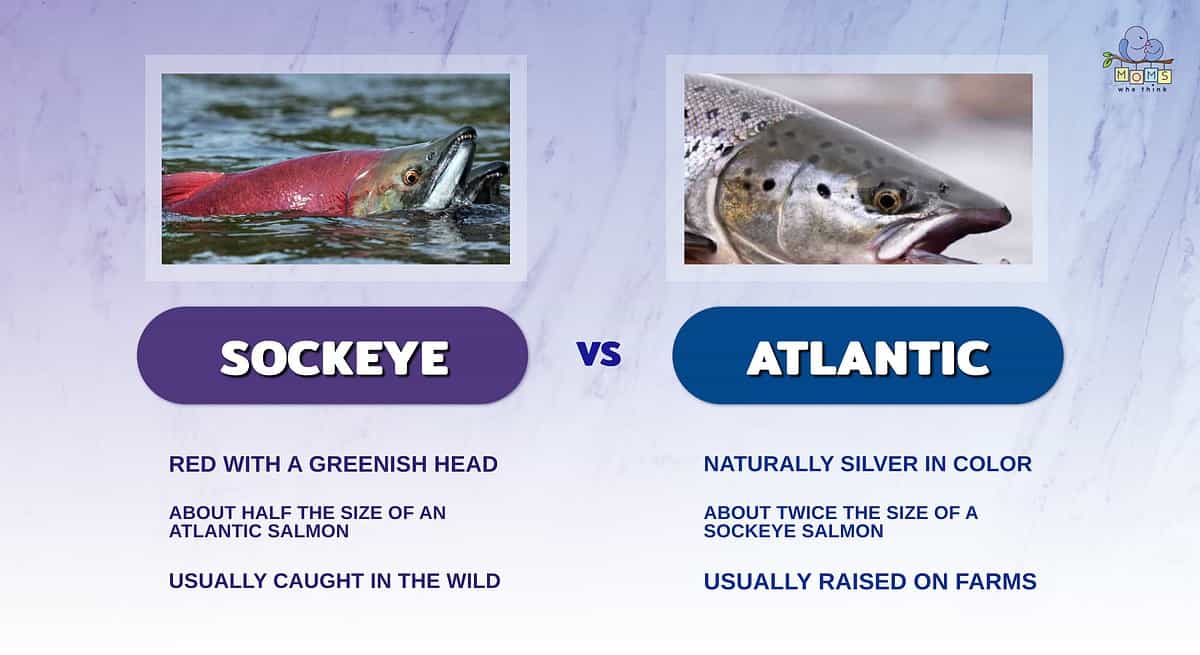
- Sockeye fish have a very distinct look, being red with a greenish head. An Atlantic salmon is naturally silver, although they are typically dyed by farmers to make them more marketable.
- An Atlantic salmon is about twice the size of a sockeye salmon.
- Sockeye salmon are typically caught in the wild. Atlantic salmon were once predominantly caught in the wild, but the market shifted to farm-raised salmon after the species became endangered in the wild.
Sockeye is suitable if you want lean fish. However, its taste is not everybody's first choice. A great people-pleaser is Atlantic salmon with a mild taste. It's also cheaper than sockeye and is always available. Both salmon species are rich in Omega-3 fatty acids and crucial minerals like potassium, copper, iron, and calcium. You will indeed have a tasty, easy-to-make, and healthy fish dish whether you choose sockeye or Atlantic Salmon.
Check out this delicious salmon recipe!
PrintOrange Rosemary Poached Salmon
Ingredients
1 cup orange juice
1 cup vegetable broth
½ cup fresh parsley leaves
3 tablespoons butter
6 garlic cloves, pressed
2 (5-inch) sprigs fresh rosemary
1 navel orange, sliced
4 (6 ounce) skinless salmon fillets (½ to ¾ inch thick)
1 teaspoon salt
2 teaspoons orange zest
½ teaspoon freshly ground black pepper
¼ teaspoon ground red pepper
Instructions
1. Place first 7 ingredients in a 5-quart oval slow cooker. Cover and cook on high for 2 hours.
2. Meanwhile, sprinkle salmon with salt, orange zest, and peppers. Cover and chill.
3. Place salmon in liquid in slow cooker. Cover and cook 30 minutes more or until desired degree of doneness. Carefully transfer salmon to a serving platter using a large spatula. Serve over orzo.
